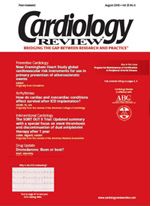Publication
Article
Cardiology Review® Online
Future treatment of congestive heart failure
As our population ages, congestive heart failure (CHF) will pose serious problems to health care. Current therapy is not effective in reducing mortality in patients with New York Heart Association functional class IV heart failure. The left ventricular assist devices used today are cumbersome, are associated with significant morbidity, and require a high level of clinical care as well as engineering care. Future therapy will involve mechanical heart assist devices.
The largest study of left ventricular assist devices to date, the Randomized Evaluation of Mechanical Assistance for the Treatment of Congestive Heart Failure (REMATCH),1 disclosed that mortality was lower in the device group, with improvements in the quality of life, compared with the group receiving medical management. Unfortunately, few patients survived for longer than 2 years. The device group was plagued by an increased incidence of infection, bleeding, and cerebrovascular accidents.
Some of the devices used today, such as the Heartmate and Novacor assist systems, are totally implanted, whereas the Thoratec VAD resides upon the abdomen. The Jarvik 2000 FlowMaker is a new, small assist device the size of a thumb. This device is an axial flow pump and is used in association with a contracting left ventricle. It allows a natural pulsatile flow with aortic valve opening. In the future, newer pumps will require less sophisticated support.
A totally implantable unit, the AbioCor implantable replacement heart,2 provides both right and left ventricular support. The unit weighs 2 pounds and energy is developed from both internal and external lithium batteries. This is accomplished via transcutaneous energy transmission. The unit is made of a titanium and polyether-based polyurethane plastic. The system is a hydraulic chamber that creates left and right ventricular pumping. This replacement heart and others to follow hold promise for the future.
Patients with poor ejection fractions and left ventricular conduction delays have shown improvements with biventricular pacing. The asynchronous contraction produced by the conduction delay is corrected by placing an atrial lead, a right ventricular lead, and a left vetricular lead via the coronary sinus. This creates synchronous contraction. Thus far, studies have had mixed results. However, the recent Comparison of Medical Therapy, Pacing, and Defibrillation in Heart Failure (COMPANION) trial3 disclosed a 19% reduction in all-cause mortality and hospitalizations in the biventricular pacing group. In the pacer-defibrillation arm, there was a 19% reduction in all-cause mortality and hospitalizations.
The neurohormonal system has been the cornerstone of therapy in CHF. Human B-type natriuretic peptide was recently introduced into the treatment of CHF with nesiritide (Natrecor). In its natural form in the body, B-type natriuretic peptide is released in response to stress and increased volumes in the ventricles. Nesiritide dilates veins, improves sodium excretion, reduces aldosterone levels, and inhibits the renin-angiotensin system as well as the sympathetic nervous system. Data have shown that the drug is safe and effective in the early treatment of CHF when compared with intravenous nitroglycerin and intravenous dobutamine. It is not arrhythmogenic.4 Intermittent outpatient therapy with nesiritide has been studied recently with favorable results, and it is hoped it will keep patients out of the hospital.
Arginine vasopressin,5 vasopeptidase inhibitors,6 and eplerenone (Inspra)7 are newer neurohormonal agents. Arginine vasopressin is elevated in CHF patients, and it causes vasoconstriction and retention of fluid via the V1A receptor. There have been early studies in animals as well as humans with V1A antagonists blocking this response. Vasopeptidase inhibitors, such as omapatrilat (Vanlev), inhibit renin-angiotensin I as well as neuroendo-peptidase, an enzyme that metabolizes endogenous vasodilator peptides, such as atrial natriuretic factor and bradykinin. These inhibitors increase the activity of endogenous vasodilators. They decrease the production
of an-giotensin II via the angiotensin-converting enzyme inhibitor. Eplerenone is a new aldosterone inhibitor that has been effective in reducing mortality in patients with myocardial infarction (MI) and left ventricular dysfunction. As opposed to spironolactone (Spironol, Aldactone), eplerenone causes less gynecomastia.
Future science will make it possible to regenerate the human cardiomyocyte. We are not certain if the hu-
man myocyte is an end-stage cell.
Proliferating myocardial cells in the myocardium could result from stimulation of cardiac resident cardiomyocytes or from circulating stem cells. Bone marrow cells have been injected into the circulation of athymic rats
to the areas of MI with proliferation. These cells have differentiated into blood cells, decreased apoptosis and scar formation, and restored left ventricular function.8
Skeletal myoblasts taken from biopsies of human muscle have been grown in culture mediums and then transplanted with catheters or surgically implanted into the area of the scar, and there have been improvements in segmental wall motion abnormalities and ejection fractions. The transplantation of skeletal myoblasts from the same donor does not require immunosuppression. Embryonic cells derived from mylocyst-stage embryos, however, create significant moral and ethical problems, as well as the need for immunosuppression. Embryonic stem cells generate into normal myocardial cells, and these may be the only cells that create a natural communication both muscularly and electrically with normal heart cells. Skeletal myoblasts turn into skeletal myocytes. The myoblasts do not form normal neuron connections with myocytes and may permit re-entrant arrhythmias. We are in the infancy of understanding transplantation and regeneration of cells and will have to develop quicker cell growth and be able to stop cell growth to prevent cardiac tumors.
Conclusion
In the future, we will be using all these modalities in specialized units. The heart failure specialist will be able to define which patient will benefit from pacing, neurohormonal drugs, intermittent neurohormonal therapy, or myocardial regeneration therapy. The most critical patients will have the option of artificial hearts or assist devices.





